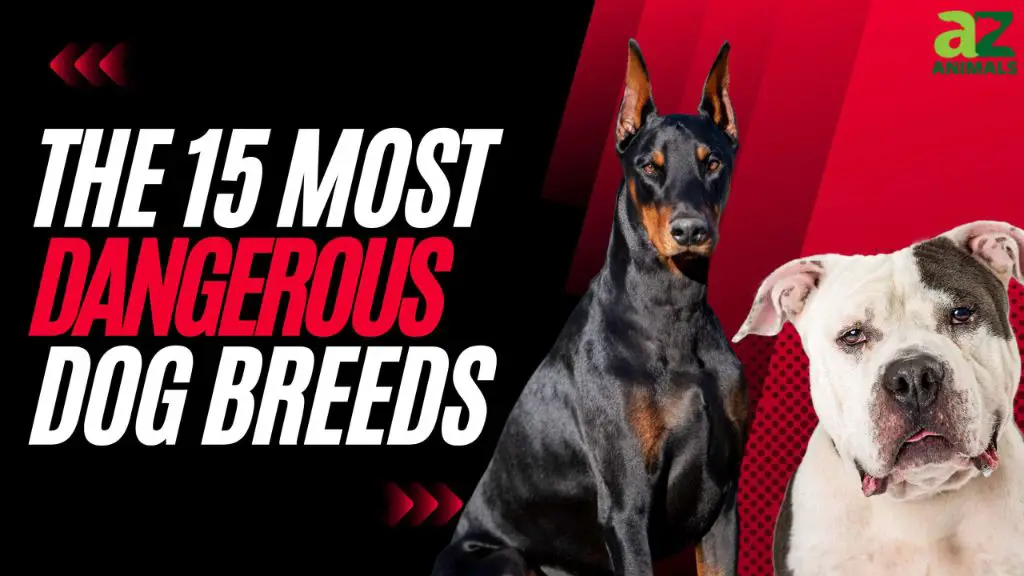Introduction
This article will provide an overview of the 30 most dangerous dog breeds based on statistics related to fatalities from dog attacks. While any dog is capable of inflicting harm, some breeds are more prone to aggression and involved in severe and fatal attacks more frequently than others. We will examine data and statistics related to fatal dog attacks in the United States, considering factors such as temperament, size, strength, prevalence of the breed, treatment by owners, and bite force. The goal is to provide a fact-based examination of dog breeds that have been involved in the most severe attacks on humans based on verified data.
It’s important to note that proper training and socialization can minimize the risk posed by any breed. Responsible pet ownership is a key factor in ensuring public safety. While genetics can influence behavior in dogs, nurture also plays a significant role. We do not intend for this article to broadly condemn entire breeds or promote breed-specific legislation, but rather to educate the public using available data.
Methodology
The selection and ranking of dangerous dog breeds was determined based on extensive research and analysis of data from the American Veterinary Medical Association (https://www.herberttrial.com/the-10-most-dangerous-dog-breeds/). Factors considered included documented cases of bites and human fatalities, the prevalence of aggressive traits within the breed, the potential for damage if an attack occurs, and the legality and restrictions placed on ownership of the breed. Breeds were ranked based on a combination of bite statistics, temperament profiles from experts, and the average severity of bites and attacks from that breed. The goal was to provide as objective an assessment as possible of the relative dangerousness of dog breeds by relying on verifiable data and research.
#10 – Doberman Pinscher
The Doberman Pinscher originated in Germany in the late 1800s. According to the Palermo Law Group, the breed was first developed around 1890 by Karl Friedrich Louis Dobermann, a tax collector who wanted a protective dog to accompany him on his rounds. Dobermans were bred to be intelligent, loyal, and fierce protectors. They quickly became popular as guard dogs and police dogs.
Dobermans have a reputation for being aggressive and dangerous, which is partly rooted in their breeding history as guard dogs. However, with proper training and socialization, Dobermans can make loyal and gentle family companions. Their protective instincts means they need experienced owners who can provide firm, consistent training.

#9 – Great Dane
The Great Dane is a very large dog breed that can grow up to 32 inches tall and weigh over 100 pounds. Due to their massive size and strength, Great Danes have the potential to inflict serious injuries when agitated or aggressive. According to one study, the breed was responsible for 37 reported attacks between 1979-1998, resulting in 3 deaths and 19 maimings. Their enormous jaws and powerful bite pressure make any wound significantly more damaging. One analysis found that Great Danes accounted for 7.1% of fatal dog attacks between 2000-2009, despite the breed’s relatively low popularity.
While Great Danes are not necessarily prone to aggression, their physical attributes mean any attack has a high risk of ending tragically. Owners must properly socialize and train this gentle giant breed to minimize territorial, protective or predatory behaviors. Proper restraints and containment are also essential when out in public given the breed’s strength and size. With responsible ownership, Great Danes can make for devoted and docile family pets.
#8 – Presa Canario
The Presa Canario is a large Mastiff-type dog breed that was originally bred for working livestock. This breed has an average weight of around 90 to 120 pounds and stands at 21 to 25 inches tall. According to some sources, the bite force of the Presa Canario is estimated to be over 500 PSI, making it one of the breeds with the most powerful bite force (Source: https://www.bestattorney.com/dog-bites/presa-canario-dog-breed.html).
Unfortunately, the Presa Canario has been used in dog fighting due to its strength and power. Some unethical breeders have selected dogs for aggression, which has contributed to inappropriate temperaments in certain lines of this breed. However, the Presa Canario has the potential to be a loyal and loving family companion with proper training and socialization from an early age. Responsible ownership and breeding is necessary to preserve the breeds’ noble working heritage.
#7 – Wolf Hybrid

Wolf hybrids are a controversial mixed breed that is a cross between a wolf and a dog.[1] Though some argue that they can make good pets in experienced homes, wolf hybrids remain controversial for several reasons:
First and foremost, wolf hybrids are closely related to wild animals. According to animal behavior experts, “wolf hybrids maintain much of the gray wolf’s prey drive and instinct to roam.”[2] This means they can be difficult to train and manage. Additionally, some studies show that wolf-dog hybrids are 19 times more likely to bite than other breeds.[3]
Between 1979 and 1998, wolf hybrids were responsible for at least 85 attacks and 19 human deaths in North America alone.[3] While not all wolf hybrids are dangerous, their close genetic ties to wild wolves makes them less predictable and reliable than the average domestic dog.
For these reasons, many jurisdictions have restricted or banned ownership of wolf hybrids. While some experienced owners insist they can be managed safely, prospective owners should carefully consider if they have the knowledge and skills to handle this powerful hybrid breed.
[1] https://www.2keller.com/library/dangerous-dog-alert-wolf-hybrids-more-likely-to-bite.cfm
[2] https://www.warriorsforjustice.com/dog-biting-statistics-by-breed/
[3] https://coloradoinjurylaw.com/blog/dog-bite-statistics/
#6 – Husky
Huskies are known for their high prey drive, meaning they often feel a strong urge to chase down other animals. Their strong hunting instincts combined with their athleticism and stamina makes huskies more prone to attack small pets or wildlife. According to the Dog Bites and Attacks: Husky, Siberian Husky by Noonan Law Group, huskies accounted for 13 dog bite-related deaths between 2005-2017. Proper training and containment are necessary for husky owners to curb their high prey drive.
5. German Shepherd
German Shepherds are known for their remarkable intelligence and strength, which is why they are commonly used as police dogs and valued for military and guard duties. According to research by Strongest Dog Bite Force: The Complete Guide, German Shepherds have a bite force between 238-291 PSI. Their strong jaws combined with their courageous and protective temperament make them excellent working dogs for law enforcement.
However, this strength and tendency for aggression should be properly managed through training. In inexperienced hands, German Shepherds can become dangerous. With consistent training and socialization, this breed can be a loyal family companion. But supervision is still recommended around strangers and other dogs.
#4 – Pit Bull
Pit bulls are medium-sized dogs that were originally bred for bull-baiting and dog fighting. They are strong, athletic, and have powerful jaws capable of inflicting severe injuries.

According to Pit Bull Attacks, pit bulls were responsible for 72% of all fatal dog bites in the United States between 2005-2017. Over this 13-year period, pit bulls killed 284 Americans, which is a rate over 7 times higher than the next closest breed, rottweilers at 45 deaths.
Due to the number of highly-publicized attacks involving pit bulls, many areas have banned the breed entirely. These bans are controversial, with proponents arguing pit bulls are inherently dangerous, and opponents claiming pit bulls are unfairly stereotyped.
Regardless of the debate around breed-specific legislation, pit bulls require experienced owners able to properly train and socialize them. Their strength and gameness mean pit bulls can potentially be dangerous in the wrong hands.
Conclusion
In summary, this article aimed to provide an overview of some of the most dangerous dog breeds based on bite statistics and risk for injury. The top 10 breeds identified were the Doberman Pinscher, Great Dane, Presa Canario, Wolf Hybrid, Husky, German Shepherd, Pit Bull, Rottweiler, Chow Chow, and American Bulldog.
While these breeds have been involved in more biting incidents historically, it’s important to note that any dog can become aggressive regardless of breed if not properly socialized and trained. No breed is inherently dangerous, and proper precautions should always be taken around unfamiliar dogs. Additionally, breed identification can be subjective, so bite statistics may not always accurately represent a breed’s temperament.

Dog bites and aggression often result from many interacting factors, including poor breeding, abuse, lack of training, or irresponsible ownership. Being a responsible pet owner who properly cares for, trains, and socializes any dog can go a long way in reducing risk. Ultimately, focusing on responsible dog ownership and safety is key to reducing dog bites across all breeds.
